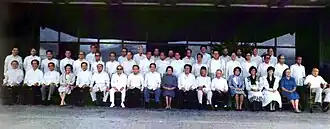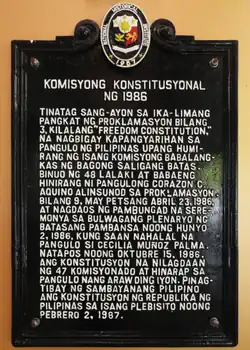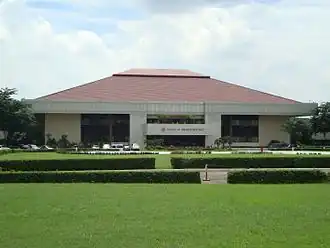Philippine Constitutional Commission of 1986
Philippine Constitutional Commission of 1986 | |
|---|---|
| Constituent assembly | |
 Commissioners of the Philippine Constitutional Commission of 1986 | |
| Type | |
| Type | |
| History | |
| Founded | June 2, 1986 |
| Disbanded | October 15, 1986 |
| Preceded by | Philippine Constitutional Convention of 1971 |
| Leadership | |
President of the Constitutional Commission | |
Vice-President of the Constitutional Commission | |
Floor Leader | |
Assistant Floor Leaders | José D. Calderón Ahmad Domocao Alonto |
| Seats | 50 |
| Meeting place | |
| Batasang Pambansa Complex | |
 |
|---|
|
|


The Philippine Constitutional Commission of 1986 was the constitutional convention tasked with drafting the present iteration of the Constitution of the Philippines in 1986.
Background
On March 25, 1986—exactly a month after the People Power revolt ended the 20-year rule of the late President Ferdinand Marcos Sr., President Corazon C. Aquino signed Presidential Proclamation No. 3, enacting a Provisional Constitution.[1] The so-called "Freedom" Constitution granted Aquino vast authority from having sole legislative power to gaining control of and general supervision over all local governments. At the same time, however, she limited those powers since the Freedom Charter was only in place for less than a year.
In December 2024, Former Chief Justice Reynato Puno, one of the authors of the Freedom Constitution, stated that Aquino ordered the writing of the provisional charter as dictated by the unusual circumstances. Following Marcos’ ouster, the 1973 Constitution ceased to have any effect. With the abolition of Congress, leaving no agency or branch of office making laws, the Freedom Charter allowed Aquino to prioritize measures “to achieve the mandate” of the people while the branches of government were being reorganized[2]:
- completely reorganize the government and eradicate unjust and oppressive structures, and all iniquitous vestiges of the previous administration;
- make effective the guarantees of civil, political, human, social, economic, and cultural rights and freedoms of the Filipino people, and provide remedies against violations thereof;
- rehabilitate the economy and promote the nationalist aspirations of the people;
- recover ill-gotten properties amassed by the leaders and supporters of the previous administration and protect the interest of the people through orders of sequestration or freezing of assets of accounts;
- eradicate graft and corruption in government and punish those guilty thereof; and
- restore peace and order, settle the problem of insurgency, and pursue national reconciliation based on justice.
Furthermore, she was presented with three options: restore the 1935 Constitution; retain and reform the 1973 Constitution; or pass a new constitution. As such, in the Freedom Constitution was Article V, which called for the adoption of a new constitution, to be composed of "not less than 30 nor more than 50 natural born citizens of the Philippines, of recognized probity, known for their independence, nationalism and patriotism." Its members would be chosen by the President after consultation with various sectors of society.
History
The 1986 ConCom was convened three months after the EDSA People Power, when in April, President Aquino signed Proclamation No. 9, announcing her administration’s plans to convene the ConCom, inviting the public to submit nominations.[3] The nominees were endorsed by various political groups and sectors, with their names published in the major newspapers along with the individuals and organizations which endorsed them.
Fresh from the events of February 1986, the People Power euphoria remained, with a general confidence that the deliberative body would bring about the necessary structural reforms in a much weakened Philippine society
The first 44 appointees were announced on May 25, 1986 during the “Reunion of EDSA Heroes” held at Camp Aguinaldo. 5 seats were offered to the opposition party Kilusang Bagong Lipunan (KBL) founded by Ferdinand Marcos and the remaining slot was offered to the Iglesia ni Cristo (INC). 4 slots were eventually filled by KBL while the INC declined the lone seat offered to it.
The ConCom formally convened on June 2, 1986 at the plenary hall of the Batasang Pambansa Complex. Elected officers of the ConCom were former Supreme Court Justice Cecilia Muñoz Palma (the first woman appointed to the Supreme Court of the Philippines) as President, former Senator Ambrosio Padilla as Vice President, and 1971 ConCon delegate Napoleon G. Rama as Floor Leader. In the formation of the various committees, the leadership asked each of the Commissioners a list of their priority or preferred committees. Based on these lists, the leadership decided on the committee assignments, including the chairs and vice-chairs of each committee.[4]
It was hoped that the Commission would complete its work within as short a period, with the need to return to a normal constitutional government truly reflective of the ideals and aspirations of the Filipino people. However, given the extensive and monumental work in drafting a new constitution facing the commissioners and their staff, they were unable to meet the September 2, 1986 completion date. Instead, they were only able to finish their work on October 12.
Sessions
- Regular Session: June 2 – October 15, 1986
Legislation
| Drafting | Enactment | Ratification |
|---|---|---|
| 1987 Constitution | ||
| Approval | October 12, 1986 | October 15, 1986 |
| Ratification | October 15, 1986 | February 2, 1987 |
Leadership
- President: Cecilia Muñoz-Palma
- Vice President: Ambrosio Padilla
- Floor Leader: Napoleon Rama
- Assistant Floor Leaders:
- Secretary General: Flerida Ruth Pineda-Romero
Members
A nomination process was held to select the members of the commission. The commission was composed of 48 national, regional, and sectoral representatives, which included lawyers, entrepreneurs, politicians, landlords, health professionals, religious leaders, labor and peasant leaders, university professors, and journalists.[5]
| Commissioner | Committee Chairmanship | Committee Vice Chairmanship |
|---|---|---|
| Yusuf R. Abubakar | Privileges | |
| Domocao Alonto | ||
| Felicitas S. Aquino | ||
| Adolfo Azcuna | Legislative | |
| Teodoro Bacani Jr. | General Provisions | |
| Jose F. S. Bengzon Jr. | Steering Committee | |
| Ponciano L. Bennagen | ||
| Joaquin Bernas, S.J. | Citizenship, Bill of Rights, Political Rights and Obligations and Human Rights | |
| Florangel Rosario-Braid | General Provisions | |
| Lino Brocka[a] | ||
| Jose D. Calderon | Local Governments | |
| Crispino M. de Castro | ||
| Jose C. Colayco | Accountability of Public Officers | |
| Roberto Concepcion | Judiciary | |
| Hilario Davide Jr. | Legislative | |
| Vicente B. Foz | Constitutional Commissions and Agencies | |
| Ed Garcia | Sponsorship | |
| Chito Gascon | Social Justice and Social Services | |
| Serafin V. C. Guingona | Sponsorship | |
| Alberto M. K. Jamir | ||
| Jose Laurel Jr. | Citizenship, Bill of Rights, Political Rights and Obligations and Human Rights | |
| Eulogio R. Lerum | ||
| Regalado Maambong | ||
| Christian Monsod | Accountability of Public Officers | |
| Teodulo C. Natividad | ||
| Ma. Teresa F. Nieva | Social Justice and Social Services | |
| Jose Nolledo | Local Governments | |
| Blas Ople | Amendments and Transitory Provisions | |
| Ambrosio B. Padilla | ||
| Cecilia Muñoz-Palma | ||
| Minda Luz Quesada | Privileges | |
| Napoleon Rama | Steering Committee | |
| Florenz Regalado | Executive | |
| Rustico F. de los Reyes Jr. | ||
| Cirilo A. Rigos | Constitutional Commissions and Agencies | |
| Soc Rodrigo | Style | |
| Ricardo J. Romulo | Judiciary | |
| Decoroso Rosales | Preamble, National Territory, and Declaration of Principles | |
| Rene V. Sarmiento | ||
| Jose E. Suarez | Amendments and Transitory Provisions | |
| Lorenzo Sumulong | - Rules
- Executive |
|
| Jaime Tadeo | National Economy and Patrimony | |
| Mary Christine Tan | ||
| Gregorio J. Tingson | Preamble, National Territory, and Declaration of Principles | |
| Efrain B. Trenas | Style | |
| Lugum L. Uka | Human Resources | |
| Wilfrido V. Villacorta | Human Resources | |
| Bernardo Villegas | National Economy and Patrimony |
See also
- First Philippine Commission
- Second Philippine Commission
- Congress of the Philippines
- Senate of the Philippines
- House of Representatives of the Philippines
References
- ^ "Proclamation No. 3, s. 1986". Official Gazette of the Philippines.
- ^ "A constitution named Freedom: The interim Charter under Cory Aquino". GMA News.
- ^ "Law Governing the Constitutional Commission of 1986". LAWPHiL Project.
- ^ "Chronology of the 1987 Philippine Constitution" (PDF).
- ^ Guanzon, Sofia (2022-03-17). "FALSE: Cory Aquino handpicked 48 persons to draft Constitution for business, foreign interests". RAPPLER. Retrieved 2024-12-27.
- ^ Dolan, Ronald R., ed. (1991). . Philippines: A Country Study (Report). GPO for the Library of Congress. p. 79.
- ^ Atienza, Maria Ela L., ed. (2019), Chronology of the 1987 Philippine Constitution (PDF), University of the Philippines Center for Integrative and Development Studies
Further reading
- Philippine House of Representatives Congressional Library
- Paras, Corazon L. (2000). The Presidents of the Senate of the Republic of the Philippines. Giraffe Books. ISBN 971-8832-24-6.
- Pobre, Cesar P. (2000). Philippine Legislature 100 Years. ISBN 971-92245-0-9.
External links
- "Law Governing the Constitutional Commission of 1986". Official Gazette. Retrieved December 20, 2012.
- Cecillia Muñoz-Palma (October 15, 1986). "Closing remarks of the President of the Constitutional Commission at the final session, October 15, 1986". Official Gazette. Retrieved November 23, 2013.
- Official Gazette Archives on the 1986 Constitutional Commission
- Records of the 1986 Constitutional Commission
- Atienza, Ma. Ela L. (1994). "Drafting the 1987 Constitution The Politics of Language". Philippine Political Science. 18 (37–38): 79–101. doi:10.1080/01154451.1994.9754188. (Published online: April 18, 2012)